In my last two posts on Islamabad (here and here) I talked about the woods and the forest trails that I love so much and take to them whenever I can.
In those woods, at the foot of the Margallas, until a few years ago, there was a very large and very old tree, believed to be several hundred years old. Its gnarled branches sprawled like an umbrella over a very large area around the tree.
It was a pipal tree (ficus religiosa). Pakistani residents of Islamabad were generally unaware of the significance of this tree. But the tree attracted many expatriate residents, mostly from South East or East Asian diplomatic missions in Islamabad. They would come and simply contemplate the tree and its surroundings. Someone had even a built a concrete kiosk and a concrete bench next to the tree for visitors to sit. The tree was believed to be a Bodhi tree.
What is a bodhi tree and how it came to be in Islamabad?
As many of us would remember from our history books, that is, if one graduated before the 1970s, for afterwards they stopped teaching history of pre-Muslim era of the subcontinent in schools, prince Siddhartha Gautuma meditated under an old pipal tree in Gaya, a village near Patna, Bihar, some 2,500 years ago. Ultimately he achieved nirvana, or was “awakenedâ€.
Consequently, the tree under which he sat was named Bodhi, meaning “awakening.†Sidhartha Gautuma became Buddha (the awakened) and the village came to be known as Bodh Gaya, the name it still carries today. The Bhodi tree that grows in Bodh Gaya today is believed to be a direct offspring of the original Bhodi tree.
In the centuries after Buddha, the Bodhi tree became a symbol of Buddha’s presence and an object of devotion for Buddhists.
A little more history before I get to the pipal tree in the woods of Islamabad.
King Ashoka (died 232 BC), the third Maurian king, converted to Buddhism and became a great advocate of the religion and actively propagated Buddhism throughout his empire. The Mauran Empire included, other than the present Northern India, the Gandhara region, which included the area around present day Islamabad, the Peshawar valley and parts of Afghanistan and Iran. Taxila (then Taxshashila), Peshawar (then Parshpura) and Charsaddah (then Pushklavati) were important cities of Gandhara. It was at this time that Taxila reached the peak of its development and became the center of Buddhism. Chandra Gupta Mauria and Asoka spent time at Taxila and so did their famous political adviser, Chanakya, who taught at Taxila.
King Asoka’s daughter, Sanghamitra, who became a Buddhist nun, is said to have taken a cutting of the Bohdi tree from Bhod Gaya to Sri Lanka and planted it at Anaradapura, the ancient capital of the island, where it still grows. Many temples throughout the Buddhist world have bodhi trees growing in them, which are or are believed to be offspring of the one from Anaradapura.
Now, back to Islamabad.
The old pipal tree that grew in the woods of Islamabad was also believed to be “descendent” of the Bodhi tree in Gaya, possibly planted, centuries ago, by a devotee, alongside a temple that might have existed there. Taxila, as the crow flies, is only a few miles from Islamabad, and is full of Buddhist monuments – stupas, statues and remains of monasteries.
In the 1980s, Ziaul Haq ruled Pakistan. In his zeal to “Islamize†the country, he encouraged and helped build madrassas all over the country, many with Saudi money. One such madrassa was built in the woods of Islamabad, not far from where the Bodhi tree stood. Over the years, the madrassa expanded, as most madrassas do, violating the building codes and encroaching upon state land, to become one of the largest madrassas in Islamabad. Today, it occupies 5-7 acres of prime real estate in Islamabad and has a sprawling building complex, and a very large playing field – probably larger than any school or college in Islamabad might have.
The madrassa houses a couple of thousand students ranging in age from 6 to 26, or even older. One sees them during breaks in their classes when they swarm into the playground and overrun the nearby children’s park, driving the children and women out. It is a bizarre sight to see young bearded men swinging and sliding on the swings and slides meant for children. Other contributions of these madrassa students to the community are: street signs defaced with posters soliciting sacrificial animal skins, and vandalized letterboxes.
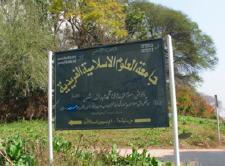
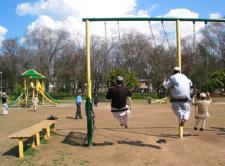
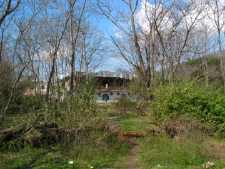

Fortunately, because of its very large girth, the Bodhi tree did not burn down completely even though it was badly damaged. It survived with half of its branches still intact. The city administration tried to preserve what was left of the tree. They even posted guards at the site for sometime after the incident to protect the tree from any further attacks. When I saw it last, a few years ago, it was still green and seemed as if it was struggling to recover from the wounds inflicted upon it.
Last week, having returned to Islamabad after two years, I decided to look up the tree, as if you would look up an old friend, and see how it was doing. I was shocked. There was no tree there! Only a few logs of the decapitated tree were lying around like dead bodies. The concrete kiosk next to it was partially demolished, its remaining walls covered with graffiti, and the bench was gone. Through the woods, I could also see the madrassa, some construction work going on it. Still expanding, I guess.
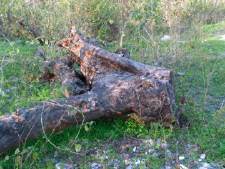
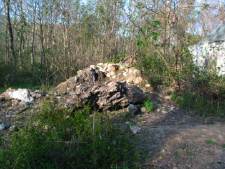
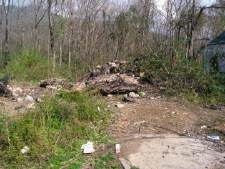
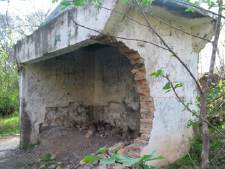
(All pictures, except the first, by the author)
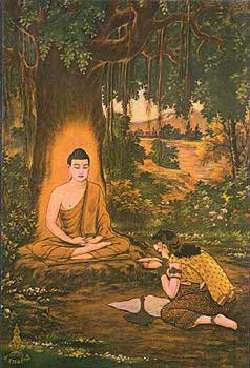




















































@prophecy: Do you have any proof that there was a guy with name “Albert Einstein”? what historical evidence do we have for his existence? You are funny but then you are a ‘liberal’ *nuff said*.
and specially about his acts referenced here…
Dialogue between Abraham,his father and his tribe:
Behold! he said to his father and his people, “What are these images, to which ye are (so assiduously) devoted?They said, “We found our fathers worshipping them.”He said, Indeed ye have been in manifest error – ye and your fathers.” hey said, “Have you brought us the Truth, or are you one of those who jest?” And by Allah, I have a plan for your idols – after ye go away and turn your backs”.. So he broke them to pieces, (all) but the biggest of them, that they might turn (and address themselves) to it. They said, “Who has done this to our gods? He must indeed be some man of impiety!” They said, “We heard a youth talk of them: He is called Abraham.” They said, “Then bring him before the eyes of the people, that they may bear witness.They said, “Art thou the one that did this with our gods, O Abraham?” He said: “Nay, this was done by – this is their biggest one! ask them, if they can speak intelligently!” So they turned to themselves and said, “Surely ye are the ones in the wrong!” Then were they confounded with shame: (they said), “Thou knowest full well that these (idols) do not speak!” : (Abraham) said, “Do ye then worship, besides Allah, things that can neither be of any good to you nor do you harm?
(Quran 21:52-66)
This is in OUR quran. Now you will ask, is there any proof that Quran exist? I wonder did you make any attempts to ask anyone in your family about the evidence of your forefathers?
Is it not unfair that you guys cowardly hide yor own beliefs and always ready to attack on other faiths? Shame on you people!
Jabirr Khan,
I don’t want to enter into a circular argument with you but it would help if you read the whole post at least once.
I mentioned in the post that the tree was set on fire a few years ago and was badly damaged. The incident was reported in the press and also voices of protest were raised. Not only there was circumstantial evidence to this destruction but also several people (more than 4) witnessed the incident.
Then sometime in the last year or two the tree, or what was left of it, quietly disappeared. My comment towards the end of the post, “no one knows, or is willing to tell, how the tree perished. Did it just die of its old age or past injuries? Or was it cut down?” is obviously about this final disappearance.
Dear website owners, this is such a great site with many important and informational discussions. But you have to find a way of managing the conversations better. A few people always attack the site and take over the discussion. Is the comments from these few really so important to you that you will sacrifice those other readers who just want a decent and polite discussion?
No one knows, or is willing to tell, how the tree perished. Did it just die of its old age or past injuries? Or was it cut down?(All pictures, except the first, by the author)
You wrote it. Didn’t you?
Common sense says there is a difference between ‘No one knows, or is willing to tell’ and ‘at least a dozen or more chowkidars and security guards of the houses in the vicinity who say they witnessed the event.’
Now EVIDENTLY You are contradicting yourself.
Thank you Adnan Sahib for your detailed response.
I was certainly not thinking that you suggested that Abraham had destructed teh tree, I was not clear on why Abraham was in teh conversation at all. I think I understand your point better now. But just so that I don’t get it wrong, I wanted a little more clearity.
YOU SAY: “Same analogy *I* personally use in case of idols on earth. If there were some idols in past who were used in worshipping then it means people of that time disrespect my God’s message by violating His order. How could I feel comfortable to keep those things with me all the time who were used to *abuse* my God?”
Do I take this to mean that you are saying that the Taliban’s destruction of Bayman statues were right?
Then, I assume you would also want all the statues in Taxila demolished? Or did I misunderstand what you are saying?
YOU ALSO SAY: “Allah even forbids the creation of images/sketches of living beings and it’s in both bible[read 2nd clause of 10 commandments] and Quran because God challenges that when you have created the image then try to give them life too.”
I guess, then, that you would consider this website a great act of blasphemy because it uses so many images of living people, and so many videos (which, I assume ae even worse than still images)? Am I understanding your position on this right?